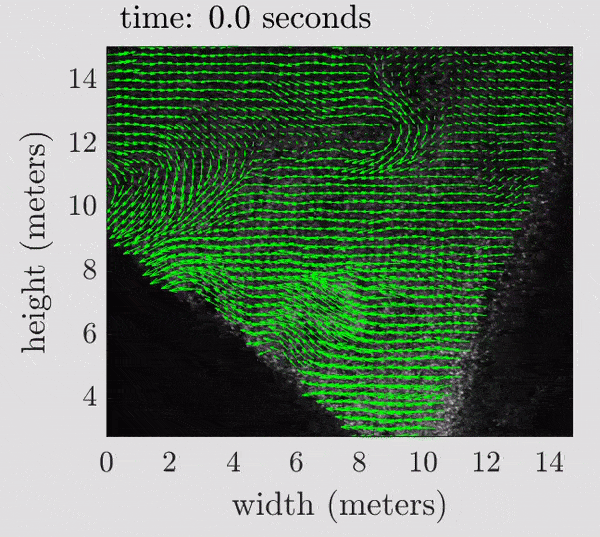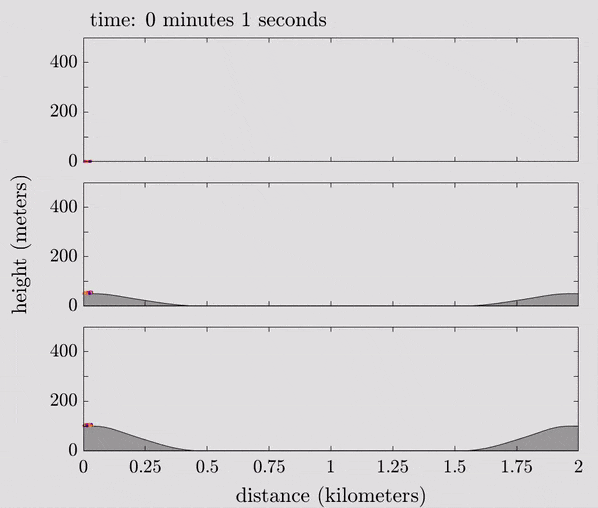"Stable" atmospheric flows

Visualization of the change in vertical turbulent structure with increasing stratification (left to right).

Change in horizontal turbulent structure with stratification.
When the air is warmer than the underlying surface, loosely-formed stratified layers develop in the lowest portion of the atmosphere known as the planetary boundary layer. While the flow is not entirely stable, it is less unstable owing to the stratification. These conditions are persistent during nighttime, throughout winter in polar regions, and during summer over oceans.
We are studying changes to the wind and air temperature in response to the stratification. The results have important implications for transport phenomena and mixing in applications ranging from air pollution to micrometeorology. Our efforts thus far have predominately used large-eddy simulations. Past elements of the work were supported by a fellowship from the US National Science Foundation.
Relevant Publications
Convective atmospheric flows
Visualization of the change in vertical turbulent structure with increasing convection (left to right).

Change in horizontal turbulent structure with convection.
In contrast to stable stratification, convection occurs during the daytime when the Earth's surface is warmer than the air. In these conditions, buoyancy generates convective plumes and other vertical motions that have a significant impact on basic atmospheric processes like dispersion. We are using large-eddy simulations to improve upon traditional understandings of how the turbulent motions vary within different regions of the convective atmosphere, and in particular how the flow transitions from the near-surface region where shear is important to the mixed layer where only buoyancy matters. The work is currently funded by start-up support from the University of Sydney.
Relevant Publications
Turbulent boundary layers

Sample video of turbulent eddies measured in the atmospheric boundary layer using snow.

Wire mesh representing a rough surface in the wind tunnel at St. Anthony Falls Lab.
There is still much to be learned about boundary layers before even considering the added complications common to geophysical and engineering applications (e.g. convection, Coriolis force, pressure gradients). Studying the simplified "canonical" turbulent boundary layer and the effect of surface roughness is a pet project of ours that we hope to maintain over many years.
Our research on this topic seeks to identify an organisation and pattern to salient coherent features (i.e. eddies) within canonical turbulent flows. The overarching long-term goal of the research is to leverage these insights for improving the ability of existing models to predict the effects of turbulence in natural systems. Numerous collaborators have contributed to our past research outputs, and funding support has included the US National Science Foundation and the Institute on the Environment.
Relevant Publications
Coarse dust transport

Animation of 20,000 dust particles (60 micron) released above the surface of an increasingly steep hill.
You may be surprised to learn that a common source of phosphorus in the Amazon is dust originating from the Saharan Desert. While recent works have observed the transatlantic journey made by the dust, it is still a mystery how the dust is lifted from the Earth's surface to the free atmosphere. In particular, global models underestimate the presence of coarse atmospheric dust, suggesting the models may be missing an important physical process that facilitates transport and vertical uplift.
We used large-eddy simulations and Lagrangian particle tracking to demonstrate the effect of hill topography on the net transport of coarse dust. Even gentle topography induces several flow features which help the dust to avoid deposition and reach several hundred meters in altitude. The work was led by Jasper Kok at UCLA and supported by the US Army Research Office.
Relevant Publications
Sediment transport applications

Measurement of bedform height for experiments ranging from a small flume to a large river.
In channel flows such as rivers, a swift current can carry bed sediment downstream. This bedload and suspended sediment transport determines how rivers slowly reshape over time and how much nutrient-rich sediment is moved downstream to be deposited in deltas. We used laboratory flume and in situ river measurements to devise a model for how fast bedforms such as ripples and dunes migrate downstream, thus allowing for improved predictions of bedload transport.
Complications arise when machinery such as marine hydrokinetic turbines (MHK) are installed on sediment beds, where the turbine tower and rotor wake induce a scour region. We helped to develop a theoretical model for predicting the depth of scour at the structural base of the turbine.
Relevant Publications
Structural aerodynamics applications

Drag force experiment on a road sign model (left) in a large laboratory channel facility (center, right).
Many road and highway signs have complex shapes which lead to similarly complex aerodynamic interactions with the wind. We helped to investigate the aerodynamic response under turbulent winds for a specific sign geometry used at rural intersections in the US. The study included laboratory experiments, field measurements, and numerical simulations. The weight distribution of the sign (i.e. top heavy), the design of the structural supports, and the resonance of the natural frequency by vortex shedding and buffeting all contributed to a strong vibrational response in the structure. The work was supported by the Minnesota Department of Transportation.
Relevant Publications
Wind turbine wake meandering

Lidar capturing wind measurements in the wake of a utility-scale turbine.
In the wake of a wind turbine, an annular shear layer develops to separate the wake core from the ambient flow outside the wake. This shear layer is strongly unstable, and the instability causes the wake to "meander" downwind of the turbine. The meandering leads to fluctuating wind loads on downwind turbines in a wind farm that can fatigue the structure. We used a comparison of wind tunnel and field measurements to identify the signature frequency of the meandering behavior. The work was supported by the Institute on the Environment.
Relevant Publications
